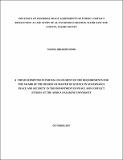| dc.description.abstract | Since time immemorial, countries all over the world have been using peace agreements as a standard approach to mitigate conflict. These agreements are used as a means to achieve peace and address the incompatibilities between the warring parties. Al-Fatah Declaration is an informal peace agreement formulated in Wajir County in 1993 to arrest the violence that was engulfing the region. Despite the successes of Al-Fatah Declaration and its consequent peace structures, insecurity in Wajir East Sub-County still continues to make global headlines. This study sought to investigate the influence of informal peace agreements on ethnic conflict resolution; a case study of Al-Fatah Declaration. The study objectives was to examine the mechanisms in the Al-Fatah declaration, the extent to which the County Government of Wajir is incorporating the principles of Al-Fatah into its peace efforts, the relevance of Al Fatah declaration to present day security realities in Wajir East Sub-County and to ascertain whether the challenges facing Al Fatah are being addressed by the County Government. This research used a case study and utilized a descriptive research design. The target population comprised of Al-Fatah elders, chiefs, the County Peace Directorate, peace forums and various organizations that were involved in the peace processes that led to the signing of Al-Fatah Declaration. The target population for the study was 172 with a sample size of 57; this is because it targeted specific people of the total population of Wajir East Sub-County. The data instruments used included questionnaires and an interview guide for key informants. The guided questionnaires were used to collect data from both key informants and other respondents. This was done by the researcher and research assistant. Quantitative data was analyzed using descriptive analysis where percentages, comparisons and inferences be made. The study found that the Al-Fatah Declaration was based on four major conflict resolution mechanisms namely; Maslah, Collective punishment, Social reconciliation and Alternative Dispute Resolution. As a result the mechanisms used have greatly contributed to the current peace being enjoyed in Wajir East Sub-County and has further been replicated in the neighboring Counties. The study found that the County Government has not fully incorporated the Al-Fatah Declaration into the County Peace Forum to drive the Al-Fatah agenda to the Peace Directorate as part of the response team. Through the trust and respect they command, the Al-Fatah elders are able to gain reliable security intelligence to tackle present day security challenges. The study found that the Al-Fatah Declaration faces several challenges such as a weak legal framework that does not recognize the declaration, resistance from Human rights groups on some of the contents of Al-Fatah such as blood compensation and lack of resources to fully carry out their activities. The study recommends for the National Government and County Governments to formalize informal peace agreements into formal law and to strengthen their implementation capacity. The National Governments and County Governments should make laws and policies that provide these informal peace agreements with legal backing giving them wider acceptance and recognition by the community. The study also recommends that neighbouring communities should adopt the Declaration so as to provide a uniform framework to manage and resolve conflict. | en_US |

